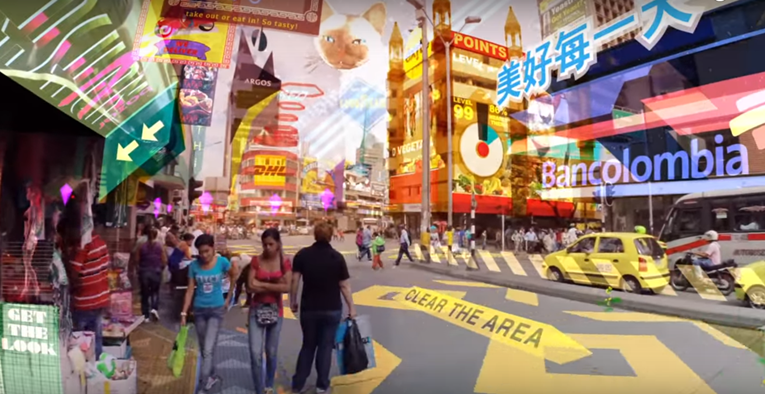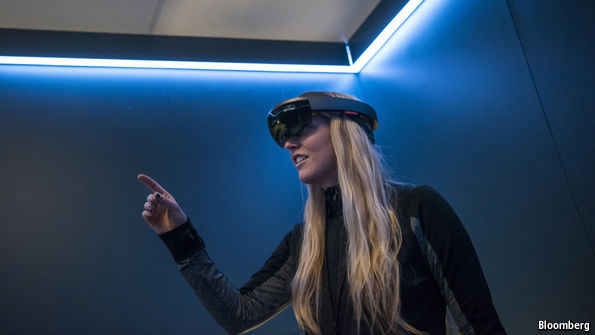2017年5月19日
AR―「拡張現実」とは何か?
すでになじみのあるARに比して、全くイメージのわかないARについての解説記事
おはようございます。
AR。なんなんだそれは?という人はまだまだ多いと思います。弊社編集部においてもまだまだとらえきれていません。それは簡単に言えば、ホロレンズ・メガネのことです。よくテレビでタレントが、大きな潜水メガネのようなものをかけて、その中で自分だけがホラー映画の映像を見て怖がるという罰ゲームをやっているのを見ますが、あれがまずそうです。
実際にはそれはARとは言えません。ARとはオーグメンテッド・リアリティの略です。オーグメントというのは音楽では「増4度」(ハ長調のファを半音上げた音)というように使われてなじみがあります。日本語では「拡張現実」と訳されています。
それに対してVRはヴァーチャル・リアリティで、これは「仮想現実」。ゲームの世界ですでに30年以上も前からなじみがあります。
ではARとはなんなのか。youtubeには、まだ実現していないARのイメージ映像がたくさんあります。

HYPER-REALITY
https://www.youtube.com/watch?v=YJg02ivYzSs
(究極的なARがこれ。)
現在市販されているホロレンズARはこうしたもの。
11 Best AR Smart Glasses (Augmented Reality Headsets)!
https://www.youtube.com/watch?v=NsbApDzZYv4&t=996s
記事の中にもありますが、今はやりの画像にウサギの耳をつけたり、ひげをつけたりするスナップチャットもARの一つといえます。あるいはポスターの写真にスマホをかざすと、写真の中身が動き出すというのもそれです。ただし、こうしたものは本当のARとはいえず、mixed realityといったほうがよさそうです。
目指すものは、メガネやスマホをかざすと、目の前に風向きのデータや空模様などが映し出されたり、実際にはそこにはない「モノ」が映し出されるというものを言うようです。
今回もイギリスのエコノミストからですが、簡潔にARの展望が述べられているので、ぜひ参考になさってください。
拡張現実(AR、オーグメンテッド・リアリティ)とはなにか?
What is augmented reality?
The Economist
Feb 12th 2017
http://www.economist.com/blogs/economist-explains/2017/02/economist-explains-8?fsrc=scn/tw/te/bl/ed/

現在、ほとんどの人が、バーチャルリアリティ(VR)のことを耳にしたことがある。グーグルからサムスン、ソニーに至るまで大手テクノロジー企業は、消費者向けコンピューティングで次なる大きなヒットになると期待している。しかし、バーチャルリアリティの非常に近しいいとこであるオーグメンテッド・リアリティ(拡張現実、AR)については耳にしたことのある人は少ない。
しかし、ARが実現すると、VRが今後与える影響よりもはるかに大きな影響を与える可能性があると多くの人は考えている。 ARとはいったい何なのだろうか。
最初に理解しなければならないことは、いま話している技術に応じて「現実」が2つのほぼ完全に異なることを意味するということである。VRの意図するものは、ユーザーが納得して探求できる世界をコンピューターシミュレーションで生み出すことである。一方、ARは「現実の」現実に固執し、コンピュータを使用し、その上に有益な情報や興味深い情報を配置する。その考えは新しいものではない。
ARの初期の祖先には、1950年代にジェット戦闘機に装着されたヘッドアップ(警告)表示装置があり、対気速度や機首方位などの情報をコクピットのガラスに直接投射して表示していた。スマートフォンを持つ多くの人々は、より高度なバージョンを経験することになる。メッセージングアプリのスナップチャットは、写真を修正して、ウサギの耳、野球帽、ありえないひげなどを人の顔につけられることで有名だ。グーグルの翻訳アプリのユーザーは、携帯電話を通りの標識やメニューなどにスマホをかざすことで、それらのテキストを自分の母語に翻訳して見ることがでる。グーグルが手を引いた「Glass」ヘッドセットは、小さな2D画像を装着者の視野のすみに投影した。
しかし、AR推進者たちははそれをはるかに超えたいと思っている。究極的には、外の他の世界とうまくやりとりしているように見える3次元画像が投影できる「スマートメガネ」を開発することである。
今のところ、最も進歩を遂げた企業はマイクロソフトだ。マイクロソフトのホロレンズヘッドセットは、一組のセンサを使用して周囲の世界のモデルを構築する内蔵型コンピュータ。そのモデルを装備すると、バーチャル 「マインクラフト」のブロックをキッチンのテーブルに置くことから、解剖学の学生が勉強するための仮想死体を生成することまであらゆることが可能となる。
VRに興味を持つ企業はほかにもある。フロリダ州に本拠を置くスタートアップのマジック・リープは、グーグルやアリババなどからの投資を含み、同様の技術に対して14億ドルの資金を得た。2014年にVR企業であるオキュラスを20億ドルで買収したフェイスブックは、VRとARの両方を同時に行うことができる眼鏡の開発を究極の目標としていると発表した。
今のところ、道のりは遠い。ホロレンズは印象的だが、想定上のスマートメガネにとってホロレンズとは、現在のスマートフォンに対する80年代のレンガ大の携帯電話のようなものだ。そしてARが消費者技術として売れだすために企業が解決しなければならないのは、技術上のな問題だけではない。社会問題もまた重要になる。
最近の携帯電話はファッションアイテムである。しかし、1980年代、携帯電話は社会的には厄介なお荷物で、それを持っていても、お高く留まった目立ちたがりだとバカにされた。グーグルのGlassのユーザーは「グラスホールズ」と呼ばれていたが、その悲劇的結末は教訓的である。その理由から、大部分の技術アナリストは、社会的道徳観がそれほど重要ではない職場でARが最初に進出すると考えている。しかし社会的道徳観は変化するし、技術は進歩する一方である。もし誰かがスタイリッシュなコンピュータ制御スマート眼鏡を考え出せたら、大ヒット間違いないだろう。
(編集部注記: グラスホールズとはグーグルグラスをかけて、他人と直接かかわるのを避け、写真やグーグル、フェイスブックやアプリなどの機能を使って他とかかわろうとする人々に着けられた呼び名。ストーカーやのぞきとほぼ同義として使われた。ホールというのはのぞきあなということ。)http://www.urbandictionary.com/define.php?term=Glasshole
編集部後記です。
スマートメガネを開発することが最終目標というわけですが、そうするとスマートコンタクトがその先になるのかなという想像が浮かびます。
しかしすでにグーグルはそこまで考えていました。しかも3年も前に。
スマートコンタクトレンズ、一歩前進:医薬大手ノバルティス、グーグルと提携
http://wired.jp/2014/07/18/google-and-novartis-hope-to-launch-smart-contact-lens-in-five-years/
以下は原文記事です。
MOST people, by now, have heard of virtual reality (VR). Giant technology companies, from
Google to Samsung to Sony, are hoping that it will be the next big hit in consumer computing. Fewer,
though, have heard of its close cousin, augmented reality (AR). Yet many people think that AR,
when it comes, could have a much bigger impact than VR ever will. What exactly is it?
The first thing to realise is that "reality" means two almost entirely different things depending on
which technology you are talking about. VR aims to generate a convincing computer simulation of
the world for its users to explore. AR, on the other hand, sticks with "real" reality, and uses
computers to layer useful or interesting information on top of it. That is not a new idea. AR's early
ancestors include the heads-up displays that were fitted to jet fighters in the 1950s, showing
information about airspeed, heading and the like projected directly onto the cockpit glass. Many
people with smartphones will have had experience of more advanced versions. Snapchat, a
messaging app, is famous for its ability to doctor photos of faces to give people rabbit ears, baseball
caps, improbable moustaches and the like. Users of Google's Translate app can, by pointing their
phones at street signs, menus and the like, see the text on them translated into their native tongue.
Google's abortive "Glass" headset projected small 2D images into the corner of its wearer's vision.
But AR's boosters want to go much further than that. The ultimate goal is to build a pair of "smart
glasses" that can project three-dimensional images that appear to interact properly with the rest of
the world. For now, the firm that has made the most progress is Microsoft. Its HoloLens headset is a
self-contained computer that uses a suite of sensors to build a model of the world around it. Armed
with that model, it can then do everything from putting a set of virtual "Minecraft" blocks onto a
kitchen table to generating virtual cadavers for anatomy students to study. Other companies are
interested, too. Magic Leap, a Florida-based startup, has attracted $1.4bn in investment, including
from the likes of Google and Alibaba, for a similar technology. Facebook, which bought Oculus, a
VR company, for $2bn in 2014, says that its ultimate goal is to produce a set of glasses that can do
both VR and AR at the same time.
For now, that is a long way off. The HoloLens is impressive, but it is to a notional pair of smart
glasses what the brick-sized mobile phones of the 1980s are to a modern smartphone. And for AR to
take off as a consumer technology, firms will need to solve more than just technical problems. Social
issues matter, too. These days a mobile phone is a fashion item. Back in the 1980s though, they
could be a social albatross, their owners mocked as self-important grandstanders. The fate of
Google's Glass, whose users were dubbed "Glassholes", is a cautionary tale. For that reason, most
technology analysts think AR will make its first inroads in the workplace, where social mores are
less important. But social mores change, and the technology only gets better. If and when someone
can come up with a pair of stylish computerised smart glasses, it will inevitably make its way onto
the high street.